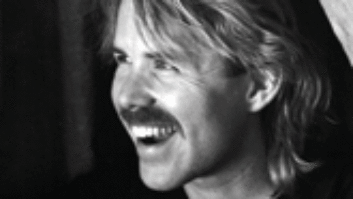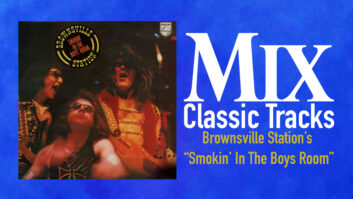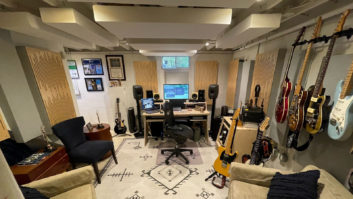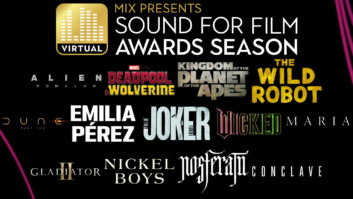
At the outset of 1986, few among the music industry’s trendspottersand prognosticators cared to predict that three white guys from NYCwould become the first rap group to top the album charts. But laterthat year that’s just what happened when the Beastie Boys hit it bigwith Licensed to Ill, a volatile disc that blends hardcore punkattitude with the hyper-driven rants of hip hop.
Today, more than a dozen years later, the Beasties-Adam Yauch (MCA),Mike Diamond (Mike D) and Adam Horovitz (Adrock)-are back with HelloNasty, their first album since 1994. Hitting the U.S. charts late lastsummer at Number One, the disc sold 681,500 copies in its first week,setting a sales record for the year.
The debut of Hello Nasty was preceded by the first leg of the band’songoing tour, which is slated to resume next month in Asia after ahiatus lasting a little over four months. Three unannounced datesintroduced the live act last summer in Philadelphia, New York City andWashington, D.C. Next the band stormed the European festival circuitfor six weeks, then returned to Yakima, Wash., for two weeks’ worth ofproduction rehearsals with an in-the-round P.A. rig supplied byBritannia Row.
As configured for the most recent U.S. leg of the tour (which endedon September 15 of last year), the system is based around six mid/highhangs, each of which includes eight narrow-Q Turbosound Flashlightenclosures and four wide-dispersion Turbosound Floodlight boxes.Arrayed to produce six stereo zones, the mid/high hangs are punctuatedalong a circular flyway by six arrays of low-frequency cabinetsmeasuring four deep in two columns.
Designed by the UK’s Brilliant Stages, the Beasties’ stage measures48 feet in circumference and features a revolving inner section. Led bycrew chief Huw Richards, the Britannia Row crew responsible for thesystem’s upkeep include Tim Woodworth, Bob Lopez, Wade Rice and KirstenSmith. Paul “Paddi” Addison presides at FOH, with fellow veteranBeastie-ite Steve Wallace in charge of monitors. Addison hails fromLondon and first became a fixture on the Beasties’ tour as a BritanniaRow systems engineer, “minding” the Beasties’ previous FOH engineer,Mario Caldato Jr. (who is also the band’s producer). When Caldatodecided to come in off the road, Addison was a natural replacement.Wallace has been with the Beastie Boys since 1992. Having spent anumber of years based in Minneapolis as an engineer for SouthernThunder Sound, he now conducts business from his home in Agoura Hills,Calif. Both Addison and Wallace directed the show’s 360-degree audioactivities using Midas XL4 consoles.
While grand in scale, the Beasties’ stage presents a clean,minimalist aesthetic, made possible in part by band-wide use of Shure’sPSM 600 Personal Stereo Monitor systems. As is often the case within-ear monitoring technology, stage levels are so low that Addison feltobliged to provide “infills” for those in the near-field audience, whowould normally get an earful from traditional sidefills and wedges.Ringing the stage in six groups, each infill battery includes twomid/high cabinets flanking a mid-only box. In addition, there are sixgroups of three subwoofers beneath the stage. Primarily intended fornear-field use, these subs provide a solid measure of seismic ambiencethat is felt by all standing atop the riser.
In the dozen-plus years since the Beasties sprung Licensed to Ill onan unsuspecting public, they have traveled along a steady path ofmusical and creative evolution. As testimony to their ever-expandingrange and depth, their current live show jumps between hardcore punk,the beat-boxing and scratching of hip hop, and even a peculiarlyBeasties brand of Latin jazz.
As the band cross freely over these musical boundaries, they arejoined onstage by an assortment of musicians. During the Latin-infusednumbers, a keyboardist and a percussionist are introduced. Anotherdrummer, known simply as AWOL, sits in for hardcore moments. For thetrio’s hip hop forays, Mix Master Mike (of DJ fame with the InvisiblSkratch Picklz) stands behind two turntables and pours out an all-vinylsonic assault that you’d swear relies upon a hidden sampler or two-butit doesn’t.
If anything has remained constant during the Beasties’ stage career,it’s that they are unpredictable. That being the case, it’s extremelydifficult for either Addison or Wallace to plan anything. “The set listis different every night, and quite often we won’t even see it until acouple of minutes before the show,” Addison says. “Then, just as often,the band won’t stick to it anyway. So you have to stay flexible.”Addison’s Midas XL4 console goes a long way toward keeping thingsmalleable. “With this band, there’s no point in overcomplicatingyourself with automation,” he says. “That’s why I think the XL4 is theperfect board. I can use as little of it as I want, or as much as Iwant, depending upon how the show progresses.”
For Addison, keeping it simple also means storing a mere threescenes in the XL4-one for each musical genre the Beasties deploy. Withthe exception of his faithful Lexicon PCM42, which is wired directly toa fader on the XL4 that he keeps under his finger all night, Addisonreturns all of his effects via a Yamaha 03D. Serving as a MIDI slave tothe XL4, the 03D changes with each scene and adjusts the level of theeffects.
In addition to the PCM42, which he uses for dub delays and “allmanner of odd noises the band and myself like” on vocals, Addison’scollection of outboard processing gear includes a Roland SDE3000 forslap echo, a Yamaha SPX1000 for drum reverb, a Lexicon PCM 70 for vocalreverb and a dbx 120X boom box, which was put to work adding a bit ofsubharmonic strength to the punk bass. All of the Shure Beta 58A radioand hard-wired microphones used for vocals are compressed throughdual-channel Summit tube DCL200 units, ten channels in total.
Despite the fact that an in-the-round setup is fraught withacoustical hazards such as a greatly intensified potential forfeedback, Addison is quick to point out the benefits of the 360-degreeplot. “Every speaker is actually closer to the audience,” he says. “Thecoverage is much more even most of the time, and I’ve found that I canget away with much less compression. It’s from about 160 Hz on downwhere the problems start. All of the energy you’re pushing into theroom starts coming back toward the center, and you can wind up withthis great big low/mid build-up in the center. Holes may open in thelower frequencies as well. You walk through the room and suddenly thebass disappears. Then you walk two more feet and it’s back. I’ve workedwith a number of systems in-the-round, and it’s been the same withevery single one. These are essentially generic problems you have todeal with.”
For Addison, combating these ills and maintaining an aura ofin-the-round equilibrium is a matter of mindful use of his BSSVaricurve EQ units. “You’re always close to the edge with anin-the-round system,” he says with the panache of one who enjoys takingcalculated risks. “If you cut too much EQ, it stops sounding natural.If you don’t cut enough, you end up with a mess, and halfway throughthe show things will be ringing and you won’t be able to find themquickly enough. With the Beastie Boys, it’s a matter of feeling yourway through the show each night and striking a delicate balance. Thenit sounds human.”
Much to Addison’s liking, Wallace is definitely not doing anythingonstage that adds to the in-the-round feedback potentials or detractsfrom the fidelity of his audio high-wire act. Wallace keeps thingschurch-mouse quiet with his Shure PSM 600 personal monitor-based designand finds that going the in-ear route has not only lowered stagevolumes, but has added other benefits as well. “With the PSM systems,we could be playing in the round, in the square or on the flat, and itwouldn’t make a difference,” Wallace says. “Our sound onstage iscompletely consistent wherever we go. The band has gotten tighter aswell. I’ve heard them comment that they can hear themselves singing andplaying quite clearly-intelligibility is definitely up.”
Prior to their discovery of in-ear technology, the Beastiesregularly thrashed about onstage amid a roiling 120 to 125dB SPL dinblaring from a monstrous contingent of wedges and sidefills. As theyears passed, they became more concerned with issues of hearing lossand, led to a large degree by Adam Yauch, the band pressed Wallace intoinvestigating whether in-ear systems would serve as a safeguard fortheir hearing while still meeting their monitoring needs. Wallace dulyassembled PSM systems for the entire band during last summer’s firstproduction rehearsals, and the band soon took to the PSM units andSensaphonics 2X earpieces. The only other monitoring devices usedonstage are a drum thumper and a pair of wedges at the DJ position,which allow Mix Master Mike to cue his records with headphones off.
Like Addison’s setup, Wallace’s 48-channel XL4 is complemented byBSS Varicurve EQ. Also like Addison, Wallace found the levels ofautomation on the XL4 to be “just right” for the Beasties. “I group alot of the input down to VCAs, so I can run a majority of the show tothe center of the console,” Wallace says. “With the scenes I program, Ichange my routing, effects on or off, and VCA levels. However, theindividual channel sends aren’t automated, so when it comes to pans orriding big, long reverbs, that’s still done manually. The automation isat a level where I don’t completely lose the feel of the mix, but itstill takes away a lot of busy work and lets me concentrate on theshow.”
In managing the seven mixes he delivers to the band, Wallace usesBSS 402 and Varicurve compression to control the varied dynamics sentto the Beta 58A RF vocal mics. A BSS 901 with four selectable bandsallows for frequency-weighted compression on Adrock’s hard-wired Beta58A microphone. To compensate for the inconsistencies inherent invinyl, Summit TLA 100 single-channel tube compressors are inserted atDJ left and right. BSS 402s are inserted on the snare top channel, onan Akai MPC3000 sampler triggered from the drum stand, and on acousticbass, electric bass and clavinet.
“With all the in-ear devices in use, I didn’t want to attempt totune my mix with racks and racks of graphics,” Wallace says of his useof compression on vocals. “This way, if I need a tweak in the top end,or there’s something welling up or not sounding right in an individualvoice, I can make very exacting adjustments without affecting theoverall quality of the mix. I don’t maintain a lot of extra EQ. For me,anything beyond what’s required gums up and changes the quality ofeverything.”
There are a total of 41 inputs on the stage, and claws, clamps andcustom mounting devices are widely used in order to minimize the numberof mic stands. Shure SM91A and Beta 52 mics are used on kick drum, andWallace and Addison combine their outputs to tailor the sound accordingto the needs of each mix. Snare top and bottom are miked with ShureBeta 57As, rack and floor tom get SM98As, and AKG 414s are used for hatand underhead cymbals left and right. In the percussion section, congalow and high are miked with SM98As. Beta 56s are used for djembe high,bongos and timbales. Djembe low is captured by a Beta 52, with a verynecessary gate at FOH. Korg left and right, a clavinet/bass station,Rhodes, acoustic bass, electric bass and DJ left and right are inputvia active DIs from Countryman. One of two electric guitar sounds isavailable on demand-a Sennheiser 421 serves up a “clean” signal, whilea Sennheiser 409 performs with the required grit when somethingconsiderably “dirty” is required.
As of this writing, both Addison and Wallace are preparing for theresumption of their in-the-round routines. After the Asian leg windsdown, no solid plans have been made regarding the tour’s future. Butwhat do you want? Let the Beastie Boys remain unpredictable.






